List of Authors
>>About this blog
Recent blog post
|
[CAM]
January 27, 2016 18:00
Ruins of Juzaburo Tsutaya "Koshodo"
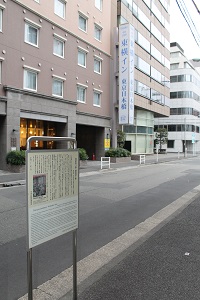
Juzaburo Tsutaya 1750-97 (Kanen 3-Kansei 9)
Tsutaya juzaburo
A representative publisher of the Edo period along with Suharaya Ichibei. It is commonly known as Tsutashige. Born in Edo Yoshiwara, he was adopted by Kitakawa. At first, he opened a shop on the Ikuma-michi outside Yoshiwara Daimon and sold Hosomi (Yukaku Guide), but in 1774 (Yasunaga 3) as a publisher for the first time, "Ichimoku Senbon Hanasumahi" (Shigemasa Kitao painting). After that, he set up a store in Aburamachi, Nihonbashi-dori, and played a part in the prosperity of the Edo publishing industry, against the backdrop of the so-called open world of the Tanuma era. The merchant was a sharp and spiky person, who had friends with many literary ink artists, players, and painters and took care of them. He collaborated with Nanpo Ota, Harumachi Koikawa, Kyoden Santo, and Makoto, and Ukiyo-e artists such as Shigemasa Kitao, Hoegata Tomosai, Utamaro Kitagawa, Katsushika Hokusai, Shakujii Toshusai, etc., and published a series of reputed works of the late Edo period Tensei. He was confiscated by the publication enforcement order accompanying the Kansei Reform, and half of his property was confiscated, but his rebellious spirit continued until he died.
(Hiroyuki Kano, Heibonsha World University Encyclopedia)
The ruins of the county mansion
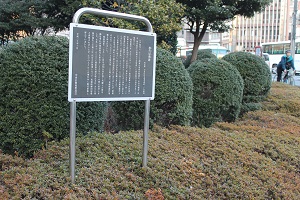
Location Near 2-chome, Nihonbashi Bakurocho, Chuo-ku
In the Edo era, there was a residence of the Kanto-gundai, which managed the collection of annual tribute, flood control, and the handling of territorial disputes in the territory under the direct control of the Shogunate (Tenryo) in various places, such as the entire Kanto area and the Tokai area. .
When Ieyasu Tokugawa entered the Kanto region, Tadatsugu Ina was appointed as Deputy Chief, and later became known as Kanto-gundai, and Ina was inherited for twelve generations. The residence was initially located in the Tokiwa Bridge gate of Edo Castle, but was burned down by the great fire of the Meiryaku era (1657) and moved to this area.
After 1792 (1792), when Tadataka Ina gained guilty and lost his leg, the magistrate of the account lived here as the Kanto county.
After being burned down in 1806 (1806), it became a deputy and was renamed Bakurocho Imperial House, but the people of Edo have long called this land a Gundai mansion.
March, 1994
Chuo-ku Board of Education
Ryogoku Hirokoji Monument
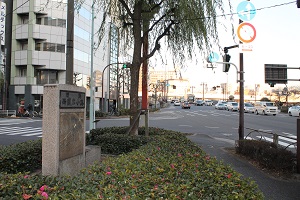 The great fire of the Meiryaku era (1657) destroyed most of the city of Edo and killed more than 100,000 people. At that time, the Sumida River, where Ryogoku Bridge was built in the Meiji town, which was built in 1000 years ago, was built in 100 years ago in the town of Hirokoji, which was built in 1000 years ago, the historic town of Hirokoji and the historical sites of Hirokoji, which was built here as one of the three historic sites of Edo's Three Great Hirokoji Temple and built here. The great fire of the Meiryaku era (1657) destroyed most of the city of Edo and killed more than 100,000 people. At that time, the Sumida River, where Ryogoku Bridge was built in the Meiji town, which was built in 1000 years ago, was built in 100 years ago in the town of Hirokoji, which was built in 1000 years ago, the historic town of Hirokoji and the historical sites of Hirokoji, which was built here as one of the three historic sites of Edo's Three Great Hirokoji Temple and built here.
November 3, 1969
Monument to the Nihonbashi Ryogoku Neighborhood Association in Chuo-ku
Yanagibashi
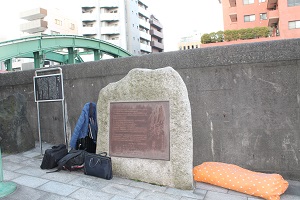
Location 2, Higashinihonbashi, Chuo-ku
1-chome Yanagibashi, Taito-ku (Kanda River)
Yanagibashi is the first bridge located at the estuary where the Kanda River flows into the Sumida River. Its origin was in the middle of the Edo period. At that time, Shimo-Yanagihara Doho-cho (Chuo-ku) and Shimoheiemon-cho (Taito-ku) on the opposite bank came by boat, but it was inconvenient and was approved in 1697 (1697) by requesting a bridge over Minamicho magistrate's office, and was completed in the following year.
At that time, there were many inns for boaters on the Sumida River around Yanagibashi, and it was bustling as seen in Kawayanagi saying, "Surve a gamma into the Yanagibashi River."
It became a steel bridge in 1887 (1887), and Yanagibashi fell in the Great Kanto Earthquake of 1923 (1923). The Reconstruction Bureau is devising the design of the first bridge at the mouth of the tributary to change the design of the boatman's return to the port. Yanagibashi incorporates the design of Eitai Bridge, referring to the bridge of the Rhine River in Germany, and was completed in 1929 (1929).
Seventy years after its completion, the number of reconstruction bridges is now decreasing in the ward, and Yanagibashi was developed as a valuable modern civil engineering heritage in 1991, and was registered in the ward Tangible Cultural Property in the same year.
March, 2002
Chuo-ku Board of Education
[Dimini ☆ Cricket]
January 27, 2016 14:00
Hiroshima Brand Shop TAU, an antenna shop in Hiroshima Prefecture, is located along Ginza 1-chome Yanagi-dori St.
By the way, "TAU" means "deliver" in the dialect of Hiroshima.
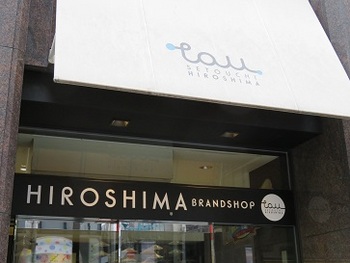
This "TAU" uses four floors of the building, from the first basement floor to the third floor, from the sales floor where Hiroshima's specialty products are collected, restaurants serving dishes using local ingredients, as well as crafts and professional sports (baseball and soccer) goods corner, event space to communicate the charm of Hiroshima, and so on.
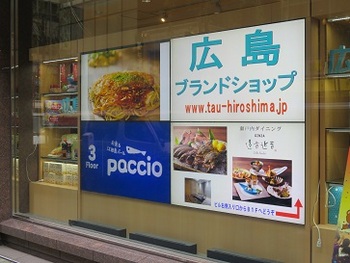
When I entered an antenna shop in many prefectures in Chuo Ward, I would definitely buy something, but what I bought on this day was baked shrimp, throat candy, and cider. shrimp, throat candy, and cider.
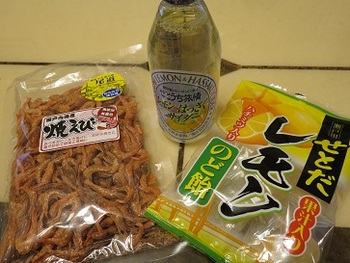
Yaki shrimp is "Setouchi Sea-produced shrimp" (Onomichi, a town of history and literature)
Throat Candy is "Sedota Setoda Lemon Throat Candy"
Cider is "Setouchi Jijo Lemon & Hassaku Cider" (using natural water of Hiroshima famous water)
All three were made from specialty products from Hiroshima Prefecture and the Seto Inland Sea, and each was delicious.
Click here for the website of the Hiroshima Brand Shop TAU. ⇒
http://www.tau-hiroshima.jp/
     
[CAM]
January 27, 2016 12:00
Bronze bell at the time of Kokumachi
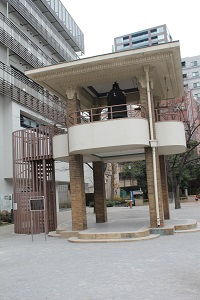
It is the bell when the people of Edo Castle were notified of the time. It is said that the bell of time was installed in Honishicho 3-chome (currently Nihonbashi Muromachi 4-chome) during the second generation Hidetada era (1605-1623). This bell was recasted in 1711 (1711) and was used until the early Meiji era, and moved to its current location in 1930 (1930).
Chuo-ku Board of Education
Bell at Ishitoki Town Hoei Era Time Bell
Designation No. 4
One of the bells of Kokumachi
Location Nihonbashikodenmacho, Chuo-ku Owners Chuo-ku, Tokyo Office
Bronze bell height 1.7 U.S. diameter 93 centimeters Shigehisa Hoei, April, name Iyo Fujiwara Shigekyu
The right is designated as a treasure.
November 3, 1953 Tokyo Metropolitan Board of Education
It was the first bell at the time of the Edo period, and at the time of the second shogun Hidetada, it was in the west circle of Edo Castle, but since the bell tower was damaged near Goza, the bell was built in Nihonbashi Kokumachi in 1657 and 1679, 1666, and 1679. The sound is said to be the sound of a long time. In 1725, a bell tower was built on the land of the new road on the north side of the former Honishi-cho 3-chome. It was collected and maintained from a total of 400 towns in Omachi Komachi Yokomachi, a commercial district. The role of the bell was also called Tsuji Bell because Genchichi Tsuji had been playing for generations from the beginning. Under the bell tower, the poet Kabumura held a haiku party under the name of the night half-tei, and was famous along with Basho-an in Fukagawa. At that time, Edo had time bells at nine locations in Nihonbashi Kokumachi, Asakusa, Honjo, Yokogawa-cho, Ueno Shibagiri-dori, Ichigaya Yahata, Meguro Fudo, Akasaka-cho, Yotsuya Tenryu-ji Temple, but Kokumachi Toki Bell is the oldest. It is. Temmacho Hell was located about two streets from Kokumachi Belfry Hall. The prisoners may have heard the sound of this bell with various thoughts, and the execution was also executed with the sound of this bell as a signal, but it was sent as if praying for the life of the prisoner. It is also reported that it is a bell of compassion. After the abolition of the late Tokugawa shogunate Toki Bell, it was the treasure of the Matsuzawa family of Kokumachi, but in September 1930, the Jushi Support Association was donated, and in September 1930, the Hoei era Toki Bell Tower was built in Jisshi Park, and the mayor of the time, Hidejiro Nagata, donated to Tokyo.
Daianrakuji Temple
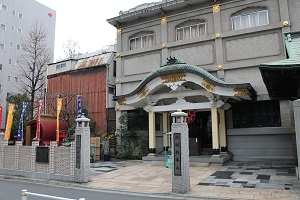
The ruins of Temmacho prison mansion
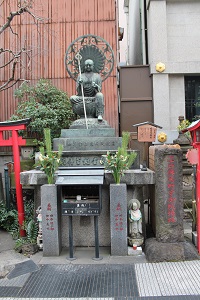
Ruins of Temmacho prison site
Location Fifth Avenue, Nihonbashi Kodenmacho, Chuo-ku
Designated November 3, 1954
The prison in Edo moved from outside Tokiwa Bridge to Kodemmacho during the Keicho era (1596-1615). The large number of Ishido swords have been appointed and managed for generations. And it survived until May 1875 (1875).
According to the records of "Remarks in Gofu", it can be seen that the scale was vast. In other words, the area was 2,618 tsubo (8639.4 square meters), and the four sides of the site were covered by moats. There was a front gate in the southwest. The prison building was divided into a parlor, a prison, a prison, and a female prison room. In 1657 (1657), there were Yoshida Shoin and more than 90 people.
Construction on October 1, 1969
Tokyo Metropolitan Board of Education
The ruins of Edo Temmacho prison mansion
No. 29 of History
The ruins of Temmacho prison mansion
Location Five destinations of Nihonbashi Kodenmacho, Chuo-ku Owner Tokyo (managed by Chuo-ku)
Land area 13.45 tsubo (22 shaku square)
The right is designated as a historical site.
November 3, 1954 Tokyo Metropolitan Board of Education
Temmacho prison moved from the area of Tokiwa Bridge during the Keicho era and lasted for about 270 years until Ichigaya prison was established in 1875, and during this time hundreds of thousands of people were sent from all over the country as Edo Temmacho prison sending. It is said to have counted. The area including the current Daianrakuji Temple, Minobubetsu-in Temple, Muraunbetsu-in Temple, Jushi Elementary School, and Jisshi Park is the site of the Temmacho prison. At that time, there were main gate in the southwestern part and an unclean gate in the northeastern part. The prison was divided into a lifted parlor, a lifter, a large prison, a peasant prison, and a female prison. The lifter was Buddhist monk, the large prison was a commoner, the peasant was a peasant, and the female prison was only a woman. There is a guardian of children and travelers at the time, which is said to be the death sentence place at the time of the precincts of Daianrakuji Temple, and the casting amount of Tesshu Yamaoka's brush states that "the prisoner's death group is separated." The role of the prison is in the rugged head, the large lord Ishide sword, the Go □(Thu + Jiang) The role of the death penalty was the famous Asaemon Yamada, 78 concentrics, 46 prisons, and it was said that he went around the prison on a monthly basis from the north-south Ryomachi magistrate. The period of one year and three months from September 1858 to December 2006, when the unprecedented turmoil was presented as Temmacho prison, i.e., Yoshida Shoin, Sanai Hashimoto, Yorizosaburo, etc. were sent to prison in Ansei's prison, and most of them were killed. It is said that those who have shed precious blood since then have reached 96 people together with the former. When he heard the sound of the bell of Kokumachi, he would have been prepared many times, saying, "It is the news of my last time." In the precincts of Shomura Unbetsuin, there is a shrine and a wooden monument of 96 members of the royal priest.
November, 1954
Edo Historic Site Preservation Sponsorship Association
Kiya Katsusaburo successive monuments
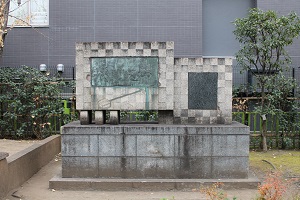
The end of Dr. Shoin
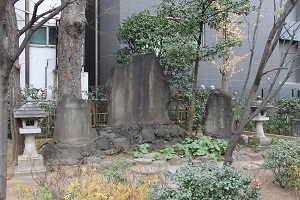
(Back side)
Eastern foot of Hagi Castle Ruins
From the vicinity of Hachimangu Shrine Miyazaki
The stone to be dug out
Donation of volunteers from Hagi City
stone monument
The body does not decay in Nobe of Musashi.
The Yamato Soul
The end of Dr. Shoin Yoshida
Dr. Shouin Yoshida was born on August 4, 1830 (C.E. 1830) as the second son of the Sugi family in Matsumoto Village, the eastern suburbs of Hagi, Choshu. I joined the Yoshida family when I was young. The name of an adult is called Tora Jiro. Since the Yoshida family was the home of the Yamaga-ryu military teacher for generations, he was a great man who studied Yamaga-ryu military science and other studies from an early age, studied the path, and worked to educate his children. In March 1854, he planned to travel abroad with the recommendation of his teacher, Shozan Sakuma, failed to get on a U.S. ship from Shimoda, and was connected to Shimoda's prison, but was sent to Temmacho prison on the way, Takanawa Sengakuji It is the famous next song that I wrote in front of the famous song. "I can't help but know that it's going to be hide, Yamato soul." Education at Matsushitamura Juku will be the greatest business. Among the many prominent men, including six barons, seventeen gifters, and fourteen rankers, among others, Ito Hirobumi, Aritomo Yamagata, and Takayoshi Kido, among others, were successful in the Meiji Restoration. The three major changes in the history of Japan are the renewal of Dahua, the establishment of the Kamakura shogunate, and the Meiji Restoration. Goshoin was tied to Ansei's prison and was once again prison in Temmacho. On July 9, 1859, he was first called to the rating office from the Choshu clan residence in Edo, but at that time he wrote in his song, "When I get a town, it's a snug that sounds very good now." . However, he was unable to move the officials of the Shogunate, and on October 22, when he was prepared to pay the death penalty in three subsequent investigations, he sent a book of perpetuence to his father, uncle, and brother. Is one of the heads of the parents who are more than the hearts of their parents." Also, knowing that the time of execution was approaching, I wrote it from October 5th to the twilight of Hatsetsu 6th in the romary record at the beginning of the statement, `` The body is decayed in Nobe of Hitake Sashi. It is said that the Yamato soul is 21 times on October 5th. Shoin sent this prisoner to Yoshigoro Numazaki, who became an island in Hachijojima Island, but handed it to Yasushi Nomura, a junior student at the Kanagawa Prefectural Ordinance at the time, twenty years later. As a result, the court at that time and the response to the inquiry, the news of the prisoners were understood, and it was a sublime book of Shoin soul that showed his own feelings and the way the students should go. It is. October 27, 1859, was the day of execution. Shoin, who left the lifter, scolded the following poems with a high spirit and told the prisoner a trick. In the prison, he recited the song of "Tatatohi" and was sentenced to obey him as a servant. On February 11, 1983, Meiji 30 years old, was awarded the fourth place on February 11, 1964, and a monument was built in the yard of the Jushi Elementary School.
[Marsha Horiuchi of Edo]
January 27, 2016 09:00
I went to Kofunecho for lunch.
1) First, we had a lunch with "Funasushi" and it was a reward for the weekend.
It has a quiet appearance, and the crisp sushi held by Mr. Itamae is delicious.
2) And if you go a little to the right, you will find Iwashiro Inari Shrine, a banner that says Success XX.
After all, in the Edo period, it was just said to be "Iseya, Inari, dog droppings", and everywhere.
You have Mr. Inari.
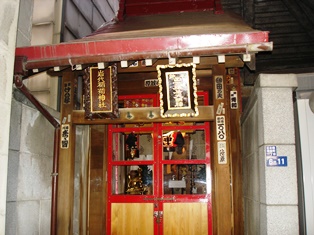
3) Then, as a souvenir to my house, I bought a dorayaki of the confectioner "Higetsudo". On the spot
He put the bean paste (the seal of rabbit and cherry blossoms), and put it in such a wonderful bag (200 yen).
Did you know that you will make dorayaki with an original brand seal here? By all means, please.
http://nitigetudou.com/

4) Finally, we went to the Kanji Art Exhibition of "Iba Sen" who was worried about Zutting.
Looking closely, I finally found that the character "Ki" is written like a person's laughing face.
I understand (the mouth is open and you can see it on a smiling face - the mouth part represents a vessel for sake and cooking -
Description of hieroglyphic characters unraveled by Shizuka Shirakawa, a master of ancient kanji studies.
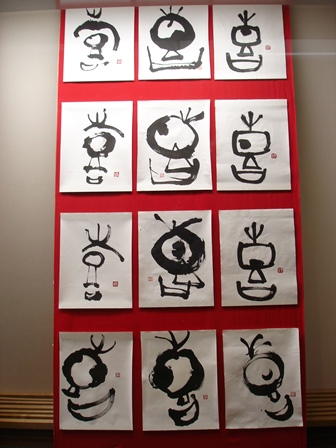 
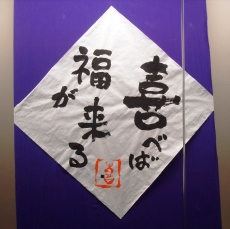
I hope you all have a good weekend when you feel refreshed.
[Slow of Satsuki's Koi]
January 26, 2016 16:00
Ningyocho Course_1
1.Sugimori Shrine → 2. Site of Saigo Takamori Yashiki (Nihonbashi Elementary School) → 3.Koami Shrine
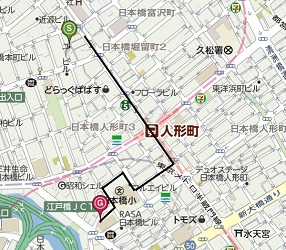
1.Ebisu God of Sugimori Shrine Nihonbashi Shichifukujin
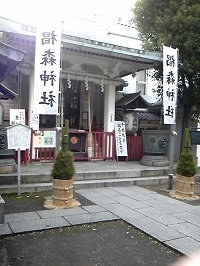 ・ ・
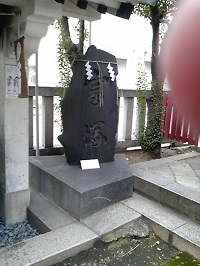
Sugimori Shrine is a shrine located in Nihonbashi Horidomecho, Chuo-ku.
In the Edo period, it was counted as one of the Mimori (Kasumori Shrine, Yanagimori Shrine, Sugimori Shrine) under Edo Castle.
It is said that the religions of the common people of Edo were gathered, and the lottery lottery was also held.
There is Tomizuka here, which was built in 1920, but it would not collapse during the Great Kanto Earthquake.
After that, Tomizuka was rebuilt in November 1953.
It is said that this Tomizuka is unparalleled and is the only one in Japan.
The lottery that appeared in the wealth of rakugo inns was held.
I thought it was Sugimori Shrine, but unfortunately it was Yushima Tenjin.
However, the inn is called Bakurocho.
It is a shrimp sord of wealth in a rakugo inn. A storyteller
This fall of the wealth of the inn should be said to be "customers, sleeping while wearing sandals."
I remembered that I had mistakenly said, "I'm sleeping with my sandals."
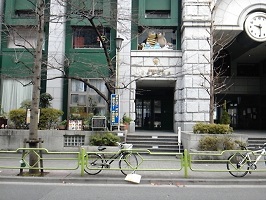 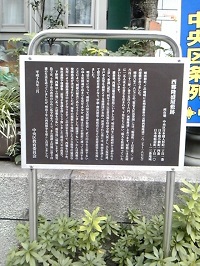
2. Site of Saigo Takamori Yashiki (Nihonbashi Elementary School)
Around the present Nihonbashi Elementary School, this is where the residence of Saigo Takamori was located.
Saigo Takamori's photographs in history textbooks are unreliable.
It seems to have been questioned in recent years.
The theory is that the upper half of the photo is his brother Tsugumichi Saigo, and the lower half is his cousin Iwao Oyama.
I leave Chuo-ku, but some say that the statue of Saigo Takamori in Ueno is not similar.
This is because my wife, Ito Saigo, who attended the unveiling ceremony, said, "Our person is a kid."
There is an episode that surprised the people involved.
The only thing that doesn't look like this is that it doesn't clear what is similar or where it is not.
In addition, I kept my favorite Satsuma dog, and my female dog name was "Tsun".
It was said that it was created based on a male dog because it was dead when the statue was created.
In addition, the actual Satsuma dog seems to be smaller than the statue.
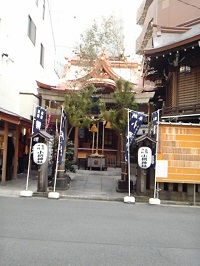 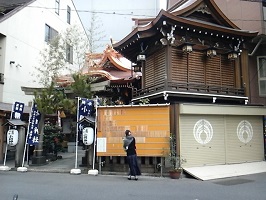
3.Koami Shrine
The restoration work was completed and the roof was neatly roofed. It was New Year's Eve that I took this picture.
On this day, the number of people who came to visit us was not interrupted.
[Tachibana]
January 26, 2016 14:00
I went to amazake Yokocho in Ningyocho on the cold Saturday of the twenty-third.
The name of amazake Yokocho is said to be derived from the fact that Owari-ya sold amazake at the intersection of amazake Yokocho and Ningyo-dori.
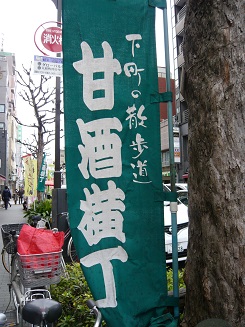 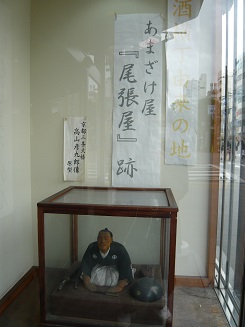
At present, Mr. Futaba, a tofu shop, can serve amazake at amazake Yokocho.
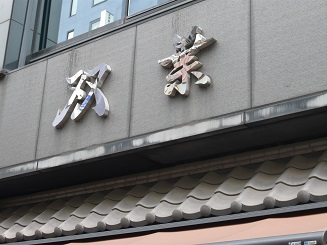 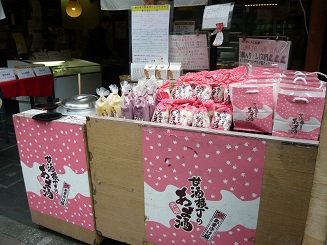
There was a bench in front of the shop, and on this day there were people who were warming up by drinking amazake in the cold.
And what is famous in amazake is Chiyoda-ku, but there are two sweet liquor stores, Mikawaya and Amanoya, located in front of Kanda Myojin Suijinmon.
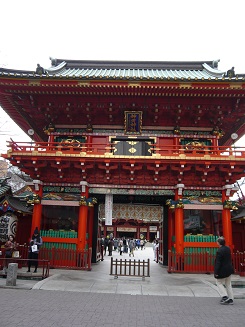 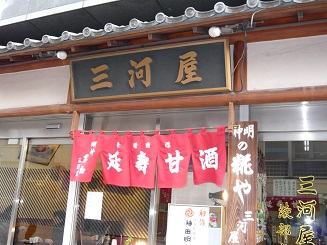 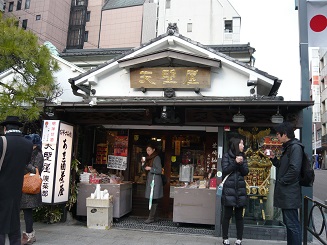
"Mikawaya" seems to have been around since the early Edo period, and "Amanoya" has been around since the late Edo period.
There are people who drink amazake deliciously here too.
It's cold, but why don't you warm your body in amazake during the cold?
|
Links
|
The great fire of the Meiryaku era (1657) destroyed most of the city of Edo and killed more than 100,000 people. At that time, the Sumida River, where Ryogoku Bridge was built in the Meiji town, which was built in 1000 years ago, was built in 100 years ago in the town of Hirokoji, which was built in 1000 years ago, the historic town of Hirokoji and the historical sites of Hirokoji, which was built here as one of the three historic sites of Edo's Three Great Hirokoji Temple and built here.












